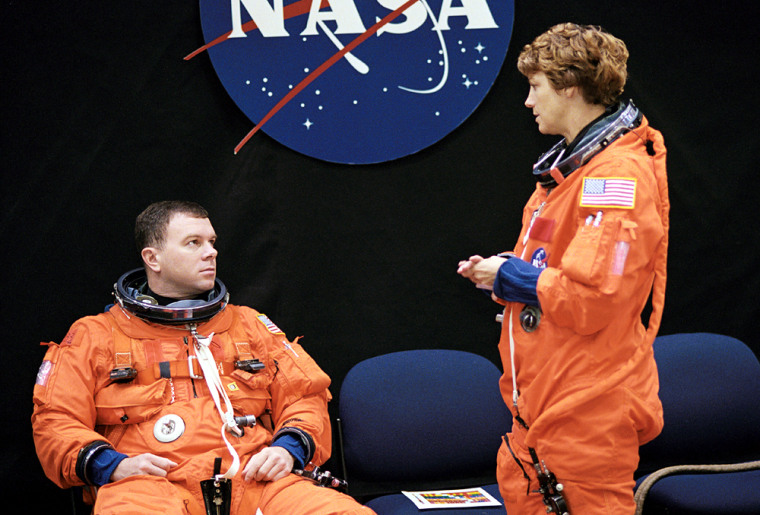There is no shortage of experience at the helm of NASA’s next space shuttle mission.
With a total of four shuttle flights and 844 hours of space time between them, STS-114 commander Eileen Collins and mission pilot James Kelly are well-prepared.
The two veteran astronauts are heading up the seven-member crew of NASA’s first shuttle flight since the Columbia disaster. Discovery, their spacecraft, is now set to launch no earlier than May 22 after being delayed Wednesday.
“The launch date is not important,” Collins said during an interview earlier this month. “We need to wait and do this right.”
The commander
A retired U.S. Air Force colonel, Collins, 48, joined NASA’s astronaut ranks in 1991. The Elmira, N.Y., native has flown on three previous shuttle flights, serving as NASA’s first female shuttle pilot during STS-63 in 1995 and then as the first female shuttle commander aboard the STS-93 mission in 1999.
“I’m not really aware that there’s any difference between male and female crew members,” Collins told reporters. “It may mean something to the rest of the world that there’s a woman commanding this flight. If so, that’s great. I hope to be a role model for young women to come into this field.”
Collins said she’s focused her primary attention on preparing herself and her crew for the STS-114 mission, which will test new tools and procedures to enhance shuttle safety.
“This crew has been so brilliant and motivated, they make my job easy,” she said. “We are aware that that the whole world is watching, but we’re focused on the mission.”
Discovery’s STS-114 flight will mark a new start for NASA’s shuttle program, which was stalled after the Columbia orbiter broke apart during re-entry on Feb. 1, 2003, killing its crew. More than two years later, NASA shuttle officials say they have a better understanding of the risks involved with human spaceflight and are confident Discovery’s flight will be the safest the agency has ever launched.
“I believe that we have studied the risks … and that at this point we are ready to say it’s time to go back and fly,” Collins said.
With an airline pilot husband, Collins has told Space.com that the risks of flight and spaceflight are well known in her home. She has also taken care to explain her upcoming mission with her two children, showing them videotapes of past missions to communicate the importance of NASA’s flight program.
“The space shuttle is critical to completing the international space station,” Collins said, adding that the station is a springboard to reach out to Mars. “And to me, that is the most exciting dream I have … to see, one day, people walking on the surface of Mars.”
The pilot
Taking stock of NASA’s space program and discussing it at home became a focus for STS-114 pilot James Kelly, 40, following the loss of Columbia’s STS-107 crew.
“You have to revisit every decision you’ve ever made to be in the program and fly in space,” Kelly said, adding that he had many discussions with his wife following the Columbia accident. “We had talked about all of that before, but this time I spent a lot more time with the kids.”
A father of four, Kelly said that while he believes the STS-114 mission carries less risk than his previous spaceflight — 2001’s STS-102 flight aboard Discovery — he took care to go over the technical details of his next launch with his two older boys, ages 15 and 14.
“It makes them more comfortable, and I talk a lot more about why I do this,” Kelly said.
A U.S. Air Force lieutenant colonel, Kelly is both shuttle pilot and an operator for both the shuttle and space station robot arms during Discovery’s flight. The mission is his second trip to the space station since his 1996 acceptance into the astronaut corps, though he admits the station will likely look much different that the picture in his memory.
“I think the biggest difference I’m going to see is the clutter,” Kelly said. “When I got there on my last mission the U.S. lab [Destiny] had just arrived and there was nothing in it.”
The lack of space shuttle flights to the space station since the Columbia accident has led to an accumulation of spare parts and other items that cannot be readily returned to Earth aboard the Russian Soyuz spacecraft currently used to ferry new crews to the station.
Kelly said he expects the STS-114 flight to be as busy as STS-102, which was NASA’s first four-person shuttle crew to deliver a fresh astronaut rotation to the space station, but will still consider it a test flight despite his previous experience with the Discovery orbiter.
“I consider every flight to be a test flight, and I agree when [Columbia investigators] said we have always been a test vehicle,” Kelly said. “Every shuttle flight has things on it that have never been done before, this one just has more.”
